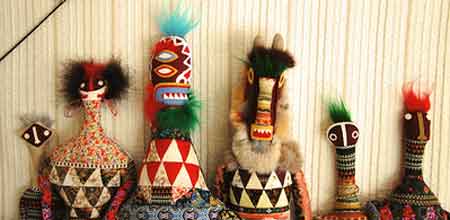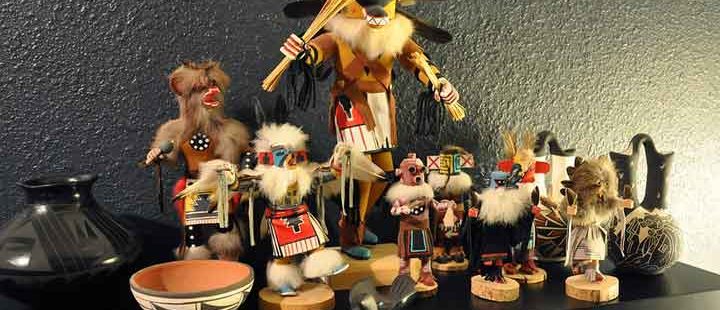Kachina dolls are traditionally carved and painted to represent the appearance of the live kachinas who come to dance in the plazas of the Hopi villages. These spirit beings participate in ceremonies, bring gifts to the children, and help the people pray for good crops, plentiful wildlife, and good health for themselves and the earth. The kachina dolls are given to girls and young women to help them connect with the kachina spirits and learn their attributes.
The most commonly seen kachina dolls are made by the Hopi Indians who live in Northern Arizona. This is because the carving tradition is still very strong among the Hopi, and many carvers support their families by selling their dolls. You can find Hopi kachinas at galleries, trading posts, and museum shops throughout the Southwest.
Buyer Beware!

You can see that kachinas are part of a living religious tradition; although kachina dolls may be made in different styles, they should still reflect the accurate appearance of the real kachina. Faces, body paint, clothing, and even what is carried in the hands are all well-defined by tradition. Part of the fun of collecting Hopi kachinas is learning how each kachina should look, and the story that goes with it.
Nonetheless, like many popular collectibles, kachina dolls are often faked. Nothing is more disappointing than spending good money on a doll only to find that it is not authentic and has no real value. The Hopi people themselves have fought this practice for many years, but the market is still flooded with fake dolls. New dolls may come from Asia, Mexico, or even factory-style Navajo workshops, and sometimes they are deliberately made to look “antique” to mislead buyers further.
Features to Wwatch For in Fake Kachinas
The good news is that it is usually fairly easy to recognize a fake kachina doll. The first step is to become familiar with the elements that identify the authentic Hopi doll; whether it is a highly detailed “fine art” kachina or a simple old-style doll painted with mineral pigments, the basic features will remain the same. This is not true of the fakes! Beware of a doll that:
- Is dressed in colorful leather or suede (purple, yellow, turquoise)
- Is covered in rabbit fur, or uses a lot of fur on the head, arms, or legs
- Has sequins, paint, or long fringe on its clothing
- Has a removable head-piece that reveals a face
- Has facial or body features that appear random or made-up
- Is made with the same body as many others–often doing an awkward “kick”
- Is made from old, rotten wood and painted poorly to appear old
- Is described as a “Navajo kachina” or as “Hopi style” or “Indian made”
Most reputable traders will not call a non-Hopi doll a kachina. However, kachinas are big business with tourists, so it’s up to the buyer to know what he or she is looking at. A doll may use the name of a real kachina (Hemis, Mudhead, Morning Singer), so when in doubt, ask questions! If you are only looking for a fun souvenir of your visit to the Southwest, buy what appeals to you–but if you want a kachina that will hold its value and have real meaning, look for an authentic Hopi kachina.
The good news is that most traders have deep knowledge about the kachinas they sell, and often buy them directly from the carvers themselves. They are a wealth of information and love to share their enthusiasm for Hopi arts. Visiting shops and galleries that specialize in authentic Hopi kachinas will help ensure that you get “the real thing,” and that you are supporting the talented artists who are helping to preserve their traditions.
- A Comprehensive Overview of Virtual Office Space Solutions for Businesses - January 1, 2025
- How Sports Nutrition Supplements Support Mental Focus and Clarity? - December 26, 2024
- Economic and Social Benefits of Technology-Driven Solutions - December 17, 2024

